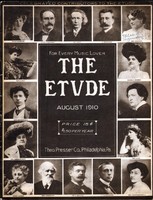BY SARAH A. PALMER.
The scientists of to-day are able to tell us just how many vibrations per second produce a given tone, just what ratio this number of vibrations bears to that of every other tone, just why any two or more tones sounded together are consonant or dissonant, what determines the "quality" of a tone, and so on through all the varied and interesting phenomena of acoustics. But all this has been determined within the last century. To Bach and the men of his time the scales, major and minor, were accepted facts in their experience, not scientific demonstrations.
In tuning all instruments having a fixed tone (clavichords, harpsichords, organ, etc.) musicians of the period encountered a strange, uncontrollable mystery. If they tuned the seven tones of the C major scale or key, for example, in perfect relation to each other, they found that C-F and G were out of tune when used as members of the Ab major scale or key. This strange, baffling discrepancy in the pitch of remotely related keys met them at every turn. None but those which are closely related could be used together, consequently they tuned perfectly in one key, modulated to the key of the dominant, subdominant or relative minor, or major, and, of necessity, ignored all keys having widely different signatures. This greatly reduced harmonic resources, and John Sebastian Bach, the innovator, the genius, was the man to find a way out of the difficulty.
To discover this mystery, let us imagine ourselves in Bach's time and place, only we must substitute a modern piano for the ancient clavichord.
In tuning all instruments the octaves must be "perfect octaves," so, starting with the lowest C on the keyboard, let us tune an upward progression, or series of perfect octaves, extending to the highest C on the keyboard—seven octaves.
The next desirable interval is the "perfect fifth," so starting again on the lowest C, let us tune an upward progression of perfect fifths. The first step of a fifth (on the keyboard) takes us to G—the fifth tone in the key of C. The second step of a fifth takes us to D, the third to A and so on, producing the following series C. G, D, A, E, B, F# (or Gb) Db, Ab, Eb, Bb, F, C, this last C being, on the piano, seven octaves from our starting point, and therefore identical with the highest C in our octave series. If, however, we have tuned in absolutely perfect fifths, as Bach's contemporaries would have done, our highest C in the series of fifths will not be identical with the highest C in the series of octaves, but will be a tone several shades higher. This is the puzzle which confronted Bach, and the musicians of his time. They said, "What can we do with this strange inaccuracy in nature? We must have our octaves tuned to the perfect interval. We want our fifths equally true, but (and here's the rub), they do not coincide—we cannot have both." Bach answered, "Let us yield a point in tuning the fifths and shorten or contract each one a little so that the seven octaves in our series of fifths will be absolutely the same length as the seven octaves in our series of octaves. It is true that in doing this all our fifths will be a little 'flat' in pitch and their inversions—the fourths—will be a little 'sharp,' but we shall become accustomed to it, and it is much better than throwing away more than half our tonal wealth when writing for clavichord or organ. With this system of tuning, all keys, major and minor, related and unrelated, will be equally available, even though each is a little out of tune." Conservatives said, "We do not believe it!" Bach replied, "I'll prove it," and he wrote "The Well-tempered (or tuned) Clavichord," a masterly work in two volumes, each one presenting a Prelude and a Fugue in each major and minor key.
C. F. Abdy Williams, an early writer, in his work on "Bach" says, "His favorite instrument was the clavichord on account of its power of expression. He learned to tune the instrument so that all the keys were at his service; he did with them whatever he wished. He could connect the most distant as easily and naturally together as the nearest related, so that the listener thought he had only modulated through the next related key of a single scale. Of harshness in modulation he knew nothing; his chromatic changes were as soft and flowing as when he kept to the diatonic genus."
Thus the present system of piano tuning, called "equal temperament," was begun and established, and pianos and organs are tuned in "equal temperament" to this day. All members of the "viol" family (violins, 'cellos, etc.) can be played in perfect tune by slight variations in finger positions. The normal human voice sings naturally in perfect intonation.



